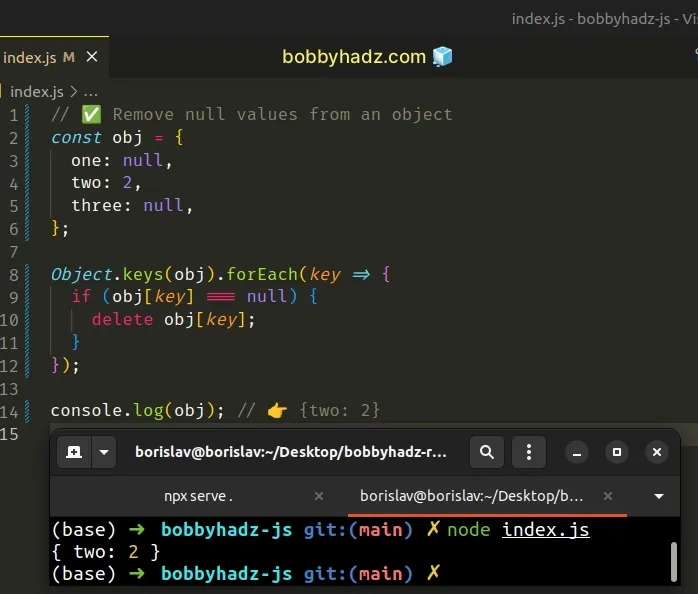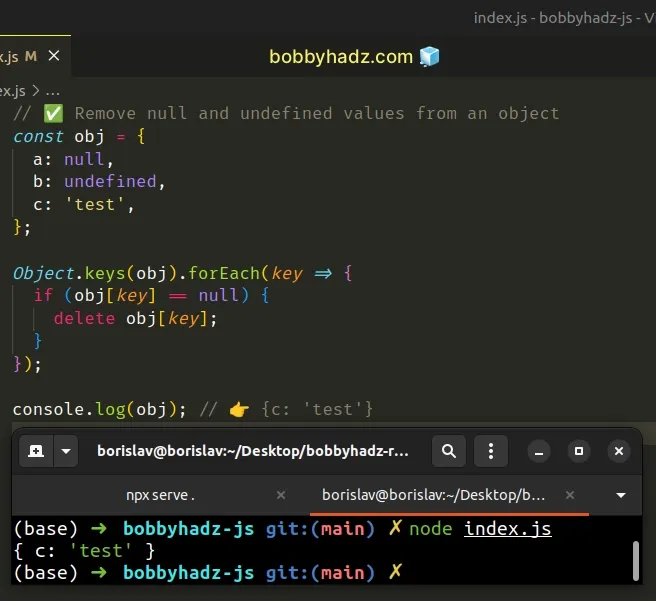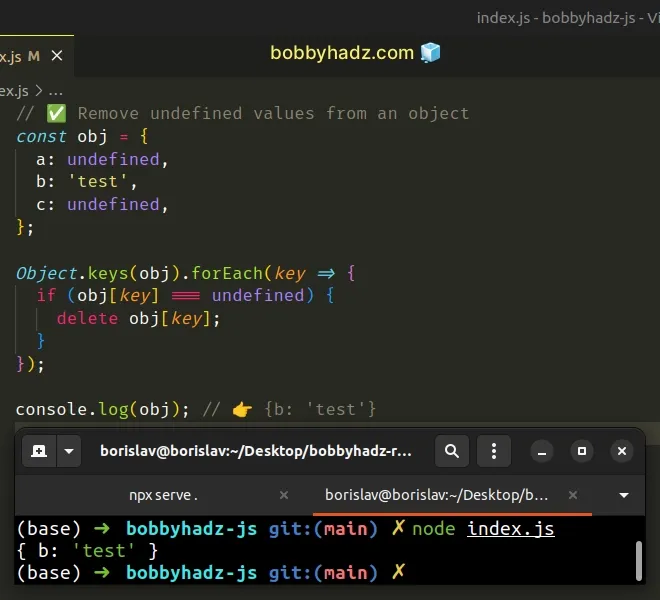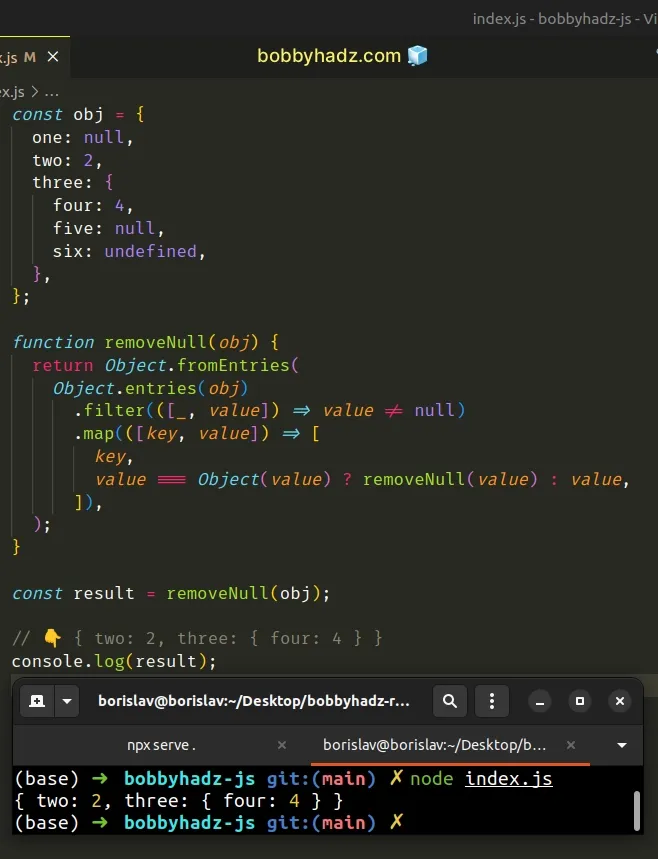Remove Null or Undefined Values from Object in Javascript
Last updated: Mar 1, 2024
Reading time·4 min

# Table of Contents
- Remove Null or Undefined Values from an Object
- Remove the
nullandundefinedvalues from a nested object - Remove the
nullandundefinedvalues from an object usingreduce() - Remove the
nullandundefinedvalues from an object using afor...inloop
# Remove Null or Undefined Values from an Object
To remove all null values from an object:
- Use the
Object.keys()method to get an array of the object's keys. - Use the
forEach()method to iterate over the array. - Check if each value is equal to
null. - Delete the
nullvalues using thedeleteoperator.
// ✅ Remove null values from an object const obj = { one: null, two: 2, three: null, }; Object.keys(obj).forEach(key => { if (obj[key] === null) { delete obj[key]; } }); console.log(obj); // 👉️ {two: 2}

If you need to remove all null and undefined values from the object, use the
loose equality (==) operator.
// ✅ Remove null and undefined values from an object const obj = { a: null, b: undefined, c: 'test', }; Object.keys(obj).forEach(key => { if (obj[key] == null) { delete obj[key]; } }); console.log(obj); // 👉️ {c: 'test'}

The code sample above removes the null and undefined values from the object.
If you only need to remove the undefined values from the object, use
undefined in the place of null.
// ✅ Remove undefined values from an object const obj = { a: undefined, b: 'test', c: undefined, }; Object.keys(obj).forEach(key => { if (obj[key] === undefined) { delete obj[key]; } }); console.log(obj); // 👉️ {b: 'test'}

The Object.keys() method returns an array containing the object's keys.
const obj = { one: null, two: 2, three: null, }; // 👇️ ['one', 'two', 'three'] console.log(Object.keys(obj));
The Array.forEach() method allows us to iterate over the array of keys.
The function we passed to the forEach() method gets called with each element
(key) in the array.
const obj = { one: null, two: 2, three: null, }; Object.keys(obj).forEach(key => { if (obj[key] === null) { delete obj[key]; } }); console.log(obj); // 👉️ {two: 2}
We check if the value, associated with the current key is equal to null.
If the condition is met, we use the delete operator to delete the key-value pair.
If you need to remove the null values from a nested object, use a recursive
function.
# Remove the null and undefined values from a nested object
To remove the null and undefined values from a nested object:
- Use the
Object.entries()method to get a two-dimensional array of key-value pairs. - Use the
filter()method to remove allnullorundefinedvalues from the array. - Call the function recursively to remove any nested
nullorundefinedvalues.
// ✅ Remove all `null` and `undefined` values from a nested object const obj = { one: null, two: 2, three: { four: 4, five: null, six: undefined, }, }; function removeNull(obj) { return Object.fromEntries( Object.entries(obj) .filter(([_, value]) => value != null) .map(([key, value]) => [ key, value === Object(value) ? removeNull(value) : value, ]), ); } const result = removeNull(obj); // 👇️ { two: 2, three: { four: 4 } } console.log(result);

Notice that we used loose not equals (!=) to remove both null and
undefined values from the nested object.
The loose equality operators (== and !=) cover both null and undefined
because null and undefined are equal when compared loosely.
console.log(null == undefined); // 👉️ true console.log(null === undefined); // 👉️ false
The Object.entries() method returns a two-dimensional array of the object's
key-value pairs.
const obj = { one: null, two: 2, three: { four: 4, five: null, six: undefined, }, }; // [ // [ 'one', null ], // [ 'two', 2 ], // [ 'three', { four: 4, five: null, six: undefined } ] // ] console.log(Object.entries(obj));
We used the Array.filter() method to
remove the null values from the array
and then used the Array.map() method to call the removeNull() function with
the value if the value is an object.
The removeNull() function removes all null values from the nested object.
Alternatively, you can use the Array.reduce() method.
# Remove the null and undefined values from an object using reduce()
This is a three-step process:
- Iterate over the object's keys using
Array.reduce(). - Check if the current key doesn't have a value of
nullorundefined. - If the condition is met, assign the key-value pair to the
accumulatorvariable.
const obj = { one: null, two: 2, three: null, four: null, five: 5, six: undefined, }; const newObj = Object.keys(obj).reduce((accumulator, key) => { if (obj[key] != null) { accumulator[key] = obj[key]; } return accumulator; }, {}); // 👇️ { two: 2, five: 5 } console.log(newObj);
We used the Object.keys() method to get an array of the object's keys and used
the Array.reduce() method to iterate over the array.
Array.reduce() is an empty object and serves as the initial value for the accumulator variable.On each iteration, we check if the current key doesn't have a value of null or
undefined.
If the condition is met, we assign the key-value pair to the accumulator
variable.
Alternatively, you can use a for...in loop.
# Remove the null and undefined values from an object using a for...in loop
This is a three-step process:
- Use the
for...inloop to iterate over the object. - On each iteration, check if the value is equal to
nullorundefined. - Use the
deleteoperator to delete eachnullorundefinedvalue.
const obj = { one: null, two: 2, three: null, four: undefined, }; for (const key in obj) { if (obj[key] == null) { delete obj[key]; } } console.log(obj); // 👉️ {two: 2}
The for...in loop allows us to iterate over the object's properties.
We check if the value of the current property is equal to null or undefined.
If the condition is met, we delete the key-value pair using the delete
operator.
Which approach you pick is a matter of personal preference. I'd use the
Object.keys() and Array.forEach() methods as I find the approach quite
direct and intuitive.
# Additional Resources
You can learn more about the related topics by checking out the following tutorials:

